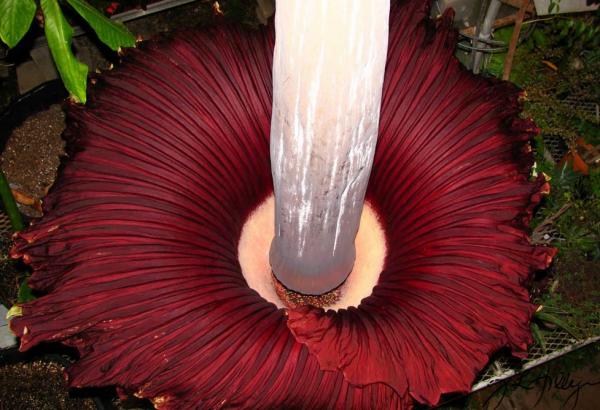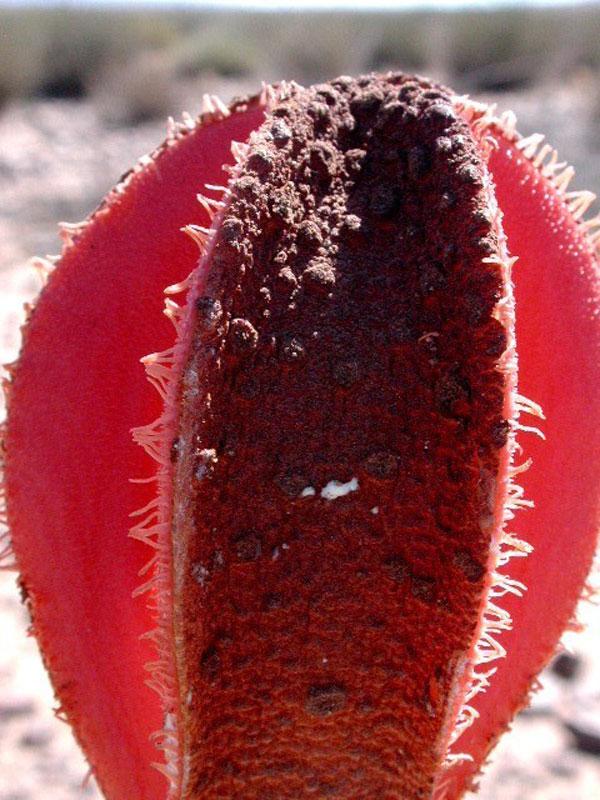
Hold Your Nose: 7 Foul Flowers
Above Titan

How's this for an evolutionary strategy? Develop such a rancid odor that you lure flies and beetles critters that would normally feed on decaying flesh and hold them hostage until they're smothered with your seeds so that when you release them, they can't help but to spread your genes.
Here are 7 fetid flowers that have followed that path. From the various corpse flowers to the western skunk cabbage, these amazing, stomach-turning flowers will have you begging for fresh air.
Titan Arum (Amorphophallus titanum)

When it comes to creating a big stink, the titan arum does it in style. Not only is it one of the biggest flowers in the world, it's also one of the smelliest. Dubbed the "corpse flower" after the putrid smell of its bloom, these flowers are huge draws at greenhouses around the world. Though their blooms are rare, the smell of rotten flesh lingers in the air for days.
The titan arum bloom is actually not a single flower, but thousands of tiny flowers, which botanists call an inflorescence. The titan arum's inflorescence is the largest in the world, typically stretching past 10 feet (3 meters) tall.
Native to the equatorial rainforests of central Sumatra in western Indonesia, the titan arum's scientific name, Amorphophallus titanum, translates to "giant misshapen phallus." The plant evolved its horrendous odor and darkly colored collar-like structure, called a spathe, to attract pollinators such as carrion beetles and flesh flies, which normally feed on rotting flesh. [See the stages of the corpse flower's bloom.]
Several titan arums have recently bloomed, including Titan 3, Metis and an unmanned plant at the Royal Botanic Gardens in Kew, England.
Stinking Corpse Lily (Rafflesia arnoldii)

Another carrion flower that is often referred to as a "corpse flower" is Rafflesia arnoldii, native to the rainforests of Sumatra and Borneo in Indonesia. These plants look and smell like a rotting carcass. These stinkers are big too: Rafflesia flowers are the largest individual flowers on Earth.
The flower, with several petal-like structures around a large opening, can weigh up to 24 pounds (11 kilograms) and grow as large as a person's torso.
Rafflesia is a parasitic flower. It has no leaves, stems, roots or chlorophyll (the chemical that helps plants photosynthesize). Any water or nutrition is siphoned from its host, the Tetrastigma vine. This makes Rafflesia very tricky to find in the wild because it grows as thread-like fibers within this vine. When it's ready to reproduce it will form a cabbage-like lump that bursts through to the outside. About a year later, the lump will open but only for a few days. Rafflesia will then grow round fruit, filled with thousands of seeds that are spread by forest animals.
Western Skunk Cabbage (Lysichiton americanus)

This flower might not look so bad, but it's called a skunk cabbage for a reason. Native to the swamps of the Pacific Northwest, the plant releases a rotten odor that flies and beetles can't resist.
The Western Skunk Cabbage is tiny in comparison to the corpse flowers. But much like the titan arum, the Western Skunk Cabbage produces a relatively large spadix and surrounding spathe, but they are only a few dozen inches tall. The flower has is rare feature its blooming stem will get hot. This heat will melt the snow around the plant to give pollinators easy access.
Another fun tidbit: Bears will eat the skunk cabbage after hibernating because it's a laxative.
Carrion Flower (Stapelia gigantea)

No matter the nickname carrion flower, toad flower, Zulu giant, starfish flower these native South African plants are like road kill to flies.
The plant itself resembles a cactus, with clumps of 4-sided spineless stems. In September, the flower blooms (see above), producing large, flesh-looking, 5-pointed stars. The flowers have the characteristic rotten smell of carrion plants, but if you find one outside it's not likely to make you gag.
The flesh-colored flower is covered with little white hairs, and attracts flies and maggots to the male and female sex organs inside its central orifice.
Stinking Root Parasite (Hydnora africana)

The parasitic plant Hydnora africana, native to the arid deserts in southern Africa, grows entirely underground.
These parasites live off the roots of the shrubby Euphorbia genus of plants. The red, flesh-colored flowers sprout from the sand, jam-packed with black beetles due to the flower's dung scent. The beetles are trapped inside the flower by downward pointing hairs, but they spill out when the flower opens.
Dead Horse Arum Lily (Helicodiceros muscivorus)

This rare, heat-producing plant can raise its temperature to help lure flies into its flower. Of course, the dead horse smell and dark-colored spathe also help.
On a warm and sunny day, the flower will unroll and release its stench while only the female flowers are receptive. Flies are lured deep within the hairy spadix, where they get trapped for an entire day. The next day, the male flowers shed their pollen. The pollen-coated flies then leave the plant, ignoring the inactive female flowers on the way out, and go on to cross pollinate another Dead horse arum lily.
Get the world’s most fascinating discoveries delivered straight to your inbox.
Eastern Skunk Cabbage (Symplocarpus foetidus)

Like the similarly named plant on the West Coast, the Eastern Skunk Cabbage is a stinky plant at home in swampy wetlands. The plant may be foul, but in Tennessee it's protected due to its status as an endangered species.
In the spring, Eastern Skunk Cabbage will flower and grow a 4-inch- long(10-centimeter) spadix and 6-inch- tall (15-cm) deep purple spathe. The plant will grow several green leaves above ground after the flower. Crushing the leaves will release the skunky odor.


